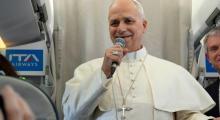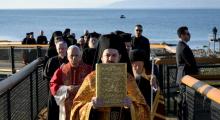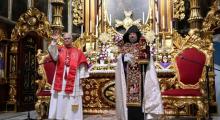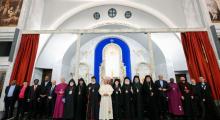Issued by the Catholic Center for Studies and Media - Jordan. Editor-in-chief Fr. Rif'at Bader - موقع أبونا abouna.org
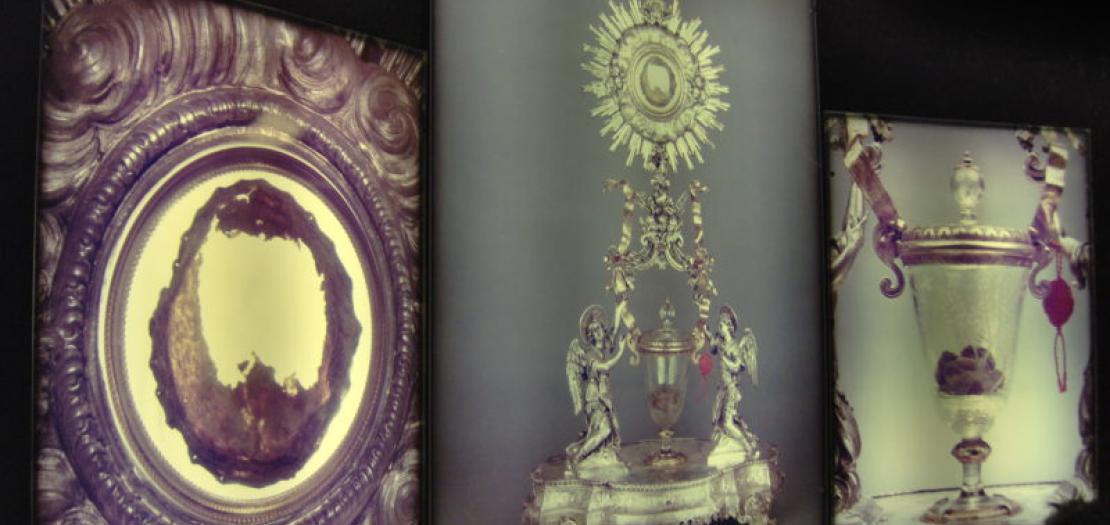
Carlo Acutis inspired an exhibition of eucharistic miracles from around the world.
There is an unusual exhibition being held at St Joseph’s church in Thame, Oxfordshire, at the moment. Organised by Anna Johnstone, a local parishioner, it is a display of 60 panels of the Eucharistic miracles of the world (altogether there are 160), accompanied by daily Adoration. The exhibition was originally the inspiration of a young Italian boy, Carlo Acutis who died in 2006 aged 15 and whose cause for beatification has been opened by the diocese of Milan.
Born in 1991, Carlo was a normal boy, lively, sporty and with a special talent for computers. Yet, not unlike Blessed Pier Giorgio Frassati of Turin, he also developed a deep love for his faith, receiving Holy Communion daily following his First Communion, going to confession weekly and praying the Rosary. The project of designing an exhibition of Eucharistic miracles took him nearly three years. Thame is one of the first parishes in the UK to organise a display; it can be requested free of charge at www.carloacutis.com
I am very curious to know how Anna became involved in the life of Carlo Acutis. She tells me that in July 2015, having experienced a difficult 18 months, including redundancy, she begged God for direction. She also prayed two novenas, one to St Joseph and the other to St Therese. On the ninth day of these novenas she found herself having a Skype interview with Carlo’s father in Assisi. She is now the governess to his two younger twin siblings. Learning more about his life, she has been “deeply moved” by his witness, saying “his sweetness, simplicity, purity and missionary heart reminds me of St Therese of Lisieux.”
What brought the exhibition to Thame? Although now living in Assisi Anna explains that she has had a home in Thame for the last ten years. In 2016 she suggested to the parish priest, Fr David Hartley, that the parish undertake a pilgrimage to Assisi. A few months later, he and 17 parishioners did so. When the pilgrimage was over, praying before the Blessed Sacrament Anna felt moved to ask Fr Hartley if he would like to have the Eucharistic Miracles exhibition in Thame. Again he was enthusiastic.
Anna describes to me the features of Carlo’s life that have led to him being proclaimed a Servant of God (the first step towards canonisation.) Although his parents were not particularly devout, he began to experience a deep attraction towards the Blessed Sacrament. Aged eleven he became a catechist and learnt about the famous Eucharistic miracle of Lanciano in 750 AD. Determined to make this and other similar Eucharistic miracles more widely known, Carlo was convinced that if people properly understood that Christ is present in the tabernacle, they would be transformed and churches would be full. He researched and collated all the authenticated Eucharistic miracles by himself and put them on-line, doing the programming for the website. It is available at www.miracolieucaristici.org
Since Carlo’s death of fulminant leukaemia, the progress of his Cause has been very rapid. From all over the world people have been making pilgrimages to his home parish in Milan, after viewing his Exhibition either on-line or in their parish. Anna reflects that the Exhibition “has really deepened and strengthened my faith. There are so many extraordinary facts associated with these Eucharistic miracles, quite inexplicable to science.”
She tells me that the Thame exhibition, accompanied by 60 hours of Adoration every week has been very well attended, with a constant flow of people coming in for prayer. “It is like the threshold, moving one into the actual presence of God.”
What are her future hopes and plans for this Exhibition? Anna has contacted the Bishops’ Conference of England and Wales and hopes that they will be interested in hosting it during the Eucharistic Congress in Liverpool in 2018. She adds, “I would also love it to be hosted in Westminster Cathedral, which is the metropolitan Cathedral of the Precious Blood.”
Anna informs me that Walsingham parish has hosted the Exhibition this summer and are thinking of having a part of it on permanent display. She herself sees it “as a tool to encourage the Eucharistic life of parishes.” She concludes our conversation with the thought that “at this time of great uncertainty in the Church, it is a way of bringing something simple, fundamental, beautiful and redolent of the transcendence of God to his people.”


